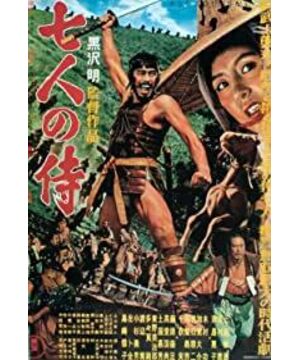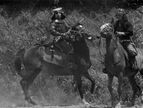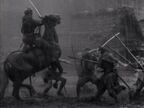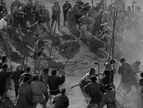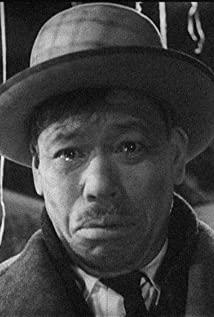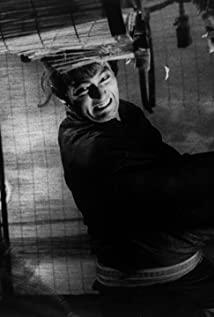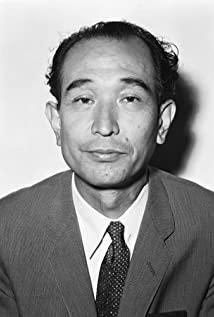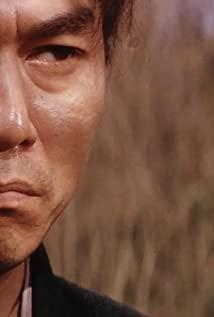The movie "Seven Samurai" is a black-and-white action war film directed by Akira Kurosawa, known as the "Emperor Kurosawa". The main actors are Toshiro Mifune and Shimura Bridge, who are known as "golden partners" with Akira Kurosawa. The film tells the story of seven samurai warriors who help farmers fight bandits and protect the village regardless of pay, fame, or sacrifice. The film naturally infuses the spirit of the samurai to the viewer, showing the belief in Bushido. This film has been artistically designed from the introduction of the opening subtitles to introduce the cast and crew with a very unique slanted font, and accompanied by drum music to render the tense atmosphere to give people suspense and a sense of crisis, and then introduce the background of the film in the form of text. It provides a social and historical background for the development of the story in the Warring States Period, when bandits were rampant, taxes were suppressed, and the people were living in poverty. The film starts from the background and creates characters with distinct personalities. Geely is one of the peasants with a rebellious spirit, and the film expresses his emotions through several close-ups of his face. At the beginning of the film, when the village was discussing matters, he suggested that he wanted to fight against the bandit, but no one responded with anger and disappointment. There was also the anger and unwillingness of his wife when he saw the bandit on fire. The film vividly expresses the image of Geely who has a spirit of resistance but is bound by the identity of a peasant. The image of the seven samurai is also very distinct, each with its own characteristics. I think the most distinctive character among the samurai is Kikuchiyo, who, despite being a peasant, yearned to squeeze into the samurai class. In the film he may not be as steady and wise as the other samurai. But he is serious about love and righteousness, and he is decisive. The film shows his interest through the close-up of his face and some details of his conversations with others, which adds a lot of interest to the film. But a rain scene in the film, which shows his frustration and guilt when he realizes that his AWOL caused the death of others, further enriches his character. Several other samurai also use several unique shots or events to express their character traits. Kanbei is far-sighted, humble, wise, and helpful. He has experienced vicissitudes of life to lead samurai and peasants to fight against bandits. Young and naive, easily moved, but constantly working hard, Katsushiro has excellent swordsmanship and specializes in art for a long time. Tibetan; the witty and brave Gorobei; the enthusiastic and optimistic Heihachi and the quiet and lawful Shichiroji. Through a variety of lenses in the film, the characters are more vividly displayed, making the viewers more empathetic. The composition of the film is very delicate. Judging from the conventional composition, many scenes in the film have a painting-like beauty. When farmers walk in large numbers to find their father, they bring flying dust and nearby branches and flowers, giving people a hazy and picturesque feeling. Then, the scene where Katsushiro and Shino first met in the sea of flowers was illuminated by light, like an oil painting, which highlighted their inner emotions. Later, Kanbei and the two inspected the Kikuchiyo vigil. The scene was layered, the bonfire was burning, and the fog was surrounded, giving people a sense of space. In addition to the conventional composition, there are also a lot of unconventional compositions in the film. The first is the shot of the horse team when the bandit descends the mountain. The black clouds in the sky account for most of it, and there is only a very narrow area in the middle of the ground for the horse team, which gives people a feeling of depression. Turning to the villagers after the thief left, the villagers discussed the composition of a large number of women lying on their stomachs and weeping from the back, which is contrary to the beauty of women in conventional movies, but also highlights the downfall of peasant women. Later, when the peasants found the samurai in the inn, there was a scene where most of them were holding rice in their hands, and there were peasants and samurai in the back. The samurai not only highlighted the low status of the peasants, but also showed the decline of the samurai. Although the whole film is black and white, it has a variety of exquisite compositions, giving people a unique aesthetic feeling, which makes people memorable. In addition, there are many unique images in the film, in which "horses" are divided into two types, the bandit's horse and the peasant's horse. The thief's horse is fat and strong, symbolizing the evil of the thief, while the peasant's weak horse symbolizes the peasant's property. The contrast between the two types of horses also symbolizes the contrast between the power of the bandit and the peasant. There is also a waterwheel in the village, which is full of the director's yearning for pastoral life. But then the burning of the waterwheel also symbolized the dire straits of farmers' lives. The use of video footage is very classic. At the beginning of the film, a push-in scene is used. First, the director uses an overhead shot of the distant view. All the farmers discuss together after learning that the thieves have plundered the wheat, and then push the camera to show that different farmers have the same sadness and frustration. The hysterical cry of the women and the silence of the men are in stark contrast, showing the poverty of the peasants and their helplessness in the face of bandits and their cowardice, for the later search for the samurai Zhang Ben. Later, I made a close-up of Geely in the crowd, highlighting that he is a key figure and the difference and progress of his thoughts, and also led to the first point of conflict. There are also several slow-motion processing in the film. When Kanbei rescued the child, the bad guy was stabbed in the back and fell down in slow motion, which not only showed the strength of the samurai, but also relieved the tension of the crowd, and at the same time caused Katsushiro's admiration as his. Add the padding. And when Kuzang confronted another samurai, he fell down in slow motion when he killed the opponent with a single blow, which also showed Kuzang's excellent swordsmanship, paving the way for him to go to the bandit to steal the musket and kill the bandit later. But the slow motion further stretches the storyline. After Kanbei and Katsushiro searched for the samurai together, there was a scene where Kanbei asked Katsushiro to test the samurai. The movements in this part were edited smoothly, highlighting the agility of the samurai. When the peasants continue to look for the samurai, there is a scene that is very delicate. The camera moves from left to right and then from right to left, which not only gives people a sense of search, but also leads to Gorobei, and also highlights the peasants want to find qualified the difficulty of the samurai. After each death of the samurai, a special shot of the tomb is processed. Heihachi's bare tomb, Kikuchiyo, inserted a samurai sword and pulled the camera up to shoot. The peasants knelt down to express their condolences and admiration. After the death of Goro Bieei, the director used a panoramic shot of Kikuchiyo, showing Kikuchiyo's guilt and loss of soul when he realized that it was his leaving without permission that killed Gorobei, which is in sharp contrast with the previous image of Kikuchiyo's rogue. Show Kikuchiyo's mental journey, paving the way for Kikuchiyo's heroic killing of the enemy and life-for-life in the future. The film presents the audience with a just war, a war of defense, the praise and praise of the seven samurai not for fame and fortune and the spirit of Bushido, but also the infinite respect and memory of these heroes. The music in the film is also very unique. The drums at the beginning are fast-paced drums with a hint of war, giving people a sense of tension and crisis, alluding to the war theme of the film. The sound of the hooves of the bandits after the drum beat also hints that this is the bandit's exclusive music. This drum music was later used in the scene where Kikuchiyo and others were ambushing the bandits, exaggerating the tension, and using the simple drum beats very cleverly. After the thieves stole the grain, the camera turned to the farmers, and the background music of the low voice sounded, giving people a sense of tragic and solemn. The perfect fusion of the camera and the music also implies that cowardice is the exclusive music of the peasants, constantly driving the development of the storyline. Later, when the peasants failed to find the samurai, the music played again to make the image of the peasants more cowardly and incompetent. The samurai's appearance music is an atmospheric wind instrument, giving people a sense of strength and momentum, highlighting the image characteristics of the samurai's firmness and bravery. When Kikuchiyo was drunk and later on his personal shots, the brisk drum beats highlighted Kikuchiyo's character, adding entertainment and fun to the film. As well as the relaxed and soothing music of Katsushiro and Shino when they first met and met again in the sea of flowers, it not only makes people feel their love, but also adds embellishment to the tense atmosphere in the film to give people a sense of relaxation. The music in the film has unique Japanese cultural characteristics and enriches the film. The handling of many details in the film is also amazing. The first is the processing of light. When the villagers looked for the wise man, the light on the wise man's face was brighter on one side and the other side was a spot of light, which made the image of the wise man firm and wise more deeply rooted in the hearts of the people. In addition, backlighting is used in many places in the film. At the beginning, the light of the bandits and horses gives people a sense of depression, but when the samurai and the peasants return to the village, the backlighting makes people feel the stalwart image of the samurai. The character designs in the film are also very special. For example, the person in the inn where the farmer stayed when he was looking for the samurai, he persuaded Kanbei when Kanbei was hesitant in the face of the peasant's request, further promoting the development of the story. Later, when there were not enough warriors, Kikuchiyo was introduced, and he described Kikuchiyo as a wild dog, which not only promoted the plot but also deepened the character image. The plot, characters, pictures, and music of the film are all in one go, the shots are unique, the structure is rigorous, and the details are exquisite. It has both commercial interest and artistic aesthetics, bringing multiple experiences to the audience, making people deeply feel Japanese culture and Bushido spirit. It is both a visual and auditory feast and a spiritual feast. It is an excellent film with endless aftertastes.
View more about Seven Samurai reviews


